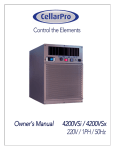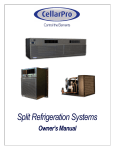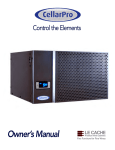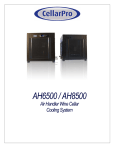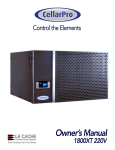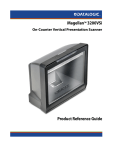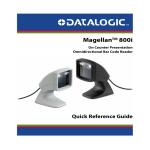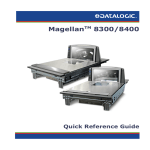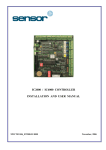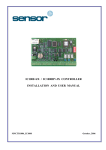Download CellarPro 4200VSx Owner`s manual
Transcript
Control the Elements Owner’s Manual – 3200VSi / 3200VSx / 4200VSi / 4200VSx CONGRATULATIONS! Thank you for purchasing a new CellarPro cooling system. Please take a minute to read through this Owner’s Manual before you unpack, install and turn on your Cooling Unit. If you have any questions about your new cooling unit, it is likely that you will find the answers in this Owner’s Manual. We also have more information on our website, including the latest version of the Owner’s Manual, at www.cellarpro.com/customerservice . If you still have questions, please don’t hesitate to contact your dealer or CellarPro directly. We can be reached during normal business hours at 1.877.726.8496. You also may contact us anytime via email at [email protected]. Contact Information: CellarPro Cooling Systems 531 Mercantile Drive Cotati, CA 94931 877.726.8496 Email: [email protected] Website: www.cellarprocoolingsystems.com Serial Number*________________________ *We recommend that you take a minute to fill-in your CellarPro serial number above. The serial number has seven-digits and can be found on the printed label on the left side of your cooling unit. Don’t forget to register your cooling unit warranty at www.cellarpro.com/register Table of Contents I. Specifications II. Installation Instructions 10 III. Operating Instructions 19 IV. Troubleshooting 30 V. Limited Warranty 32 4 3 I. Specifications Specs and Cut Sheets Model Weight Dimensions (inches) WxDxH 3200/4200VSi 14.1 x 25.1 x 19.6 (incl.drain) 115 3200/4200VSi* 14.5 x 29.3 x 19.7 (incl. duct hood & drain) 123 3200/4200VSx 14.5 x 27.6 x 19.7 (incl. exterior case & drain) 123 Running Compressor Amps 9.2 – 3200 11.5 – 4200 * With optional duct hood 3200VSi / 4200VSi Cut Sheet 4 3200VSi / 4200VSi (with Rear Duct Hood) - Cut Sheet 3200VSx / 4200VSx Cut Sheet 5 Placement CellarPro 3200 and 4200 Series cooling units are designed to be installed THROUGH THE WALL, so that the rear and the front of the cooling unit DO NOT SHARE THE SAME AIR SPACE. The rear of the cooling unit must be installed in a space that is at least as large as the wine cellar unless the rear intake and exhaust are ducted. Both the front and the rear of the cooling unit require a minimum clearance of 8 inches. These units also can be placed completely INSIDE or OUTSIDE the cellar when used in combination with our duct kits. Ambient Environment 3200VSi / 4200VSi - designed for internal use only (ie sheltered from outdoor weather), the rear of the unit can be exposed to temperature conditions ranging from 40 to 115°F. 3200VSx / 4200VSx – designed for external use, the rear of the unit can be exposed to temperature conditions ranging from 40 to 115°F. Refer to the Installation section for additional requirements for outdoor exposures. PLEASE NOTE: With our (optional) crankcase heater, all of our cooling units can be used in environments down to 20°F, and with our (optional) low ambient kit, all of our cooling units can be used in environments down to -20°F. CellarPro cooling units are not designed to heat the cellar space, so if temperatures inside the cellar drop below proper wine storage temperatures, the cooling unit cannot create heat inside the cellar. Insulation CellarPro cooling units are designed to be installed inside wine cellars that have proper insulation, moisture barriers and an airtight seal from the environment outside the cellar. Interior walls and floor should have a minimum of R-11 insulation, and a vapor barrier on the warm side of the insulation. The ceiling should 6 have a minimum of R-19 insulation and a vapor barrier on the warm side of the insulation. Doors also should be insulated and tightly sealed with weather s t r i p p i n g a r o u n d t h e p e r i m e t e r o f t h e d o o r . Surface-mounted fixtures are recommended over recessed lighting, which can allow air to leak into the cellar. It is important that all walls, joints, doors and windows, electrical outlets and/or switches, pipes, vents and light fixtures be sealed to prevent air and moisture from entering the cellar. If there is a leak in the cellar, the cooling unit will build up excess condensation. CellarPro 3200 and 4200 cooling units are equipped with a condensate management system, which includes a stainless steel pan, a thermostaticallycontrolled electric heating element, and an overflow drain at the rear of the cooling unit. We strongly recommend that the overflow drain line (shipped loose with the cooling unit) be connected to the overflow drain (as shown in the installation section), and that the cooling unit be mounted to tilt slightly backwards, so that any overflow condensate is channeled safely to the overflow drain line. In addition, we recommend turning on the electric heating element to burn off excess condensate that accumulates in the stainless steel pan during the initial cooling of the cellar and during high run-times, as well as in high-humidity environments. Fan Speeds Your fan speed setting will need to be on “High” under the following conditions: - As the thermal load of the wine cellar increases - As ambient temperatures increase - As the static load from ducting (if any) increases due to factors including the length of the duct run, turns, vent grills and/or reducers Ventilation Adequate ventilation is critically important for the proper operation of your CellarPro cooling unit. OUTSIDE THE CELLAR (At the rear of the cooling unit) Condenser Air Exhaust. CellarPro 3200 and 4200 Series cooling units create significant hot air which must be exhausted into an appropriately-sized space in order for the heat to dissipate. If the space is constrained and/or too small, 7 the heat will not dissipate. In this event, the cooling unit will be forced to recirculate its hot air exhaust and/or the static pressure will back up the cooling unit. If this happens, the cooling unit’s ability to create cold air inside the cellar will be compromised. Condenser Air Intake. The condenser coils require access to cool air in order for the cooling unit to produce cold air. In addition, the cooling unit must be installed so that, after its installation, the condenser coils are accessible for periodic cleaning or replacing of the filter. The rear of the cooling unit must be installed in a space that is at least as large as the wine cellar unless the rear intake and exhaust are ducted. Both the front and the rear of the cooling unit require a minimum clearance of 8 inches. Ducting. CellarPro 3200 and 4200 units allow the condenser air intake and exhaust each to be ducted up to 50 equivalent feet with 8” diameter ducting, or 100 equivalent feet with our auxiliary fan and 8” diameter ducting. We offer two rear duct kits (sold separately) that attach to the rear of the cooling unit. INSIDE THE CELLAR (At the front of the cooling unit) Evaporator Air Intake. CellarPro cooling units should be mounted at the highest point inside wine cellars, so that warm air – which rises – will be the first to pass over the evaporator coils, which are located behind the grill on the face of the cooling unit. When the warm air passes across the evaporator coils, heat is removed the air, and the resulting cold air is exhausted into the cellar. To ensure proper airflow, minimum clearance of 12” is required in front of the cooling unit. Evaporator Air Exhaust. Cold air is exhausted at the top front of the cooling unit. Because CellarPro cooling units are located at the highest point inside wine cellars, the cold air exhaust eventually will drop to the bottom of the cellar. To ensure proper airflow and reduce temperature stratification inside the cellar, the space in front of the cold air discharge should be clear of any obstructions, including wine bottles, wine racks, etc. Ducting. CellarPro 3200 and 4200 units allow the evaporator air intake and exhaust each to be ducted up to 50 equivalent feet with 8” diameter ducting. We offer a front duct kit (sold separately) that attaches to the front of the cooling unit. We also offer a remote control panel kit that can be installed remotely (up to 10 feet) from the cooling unit, either inside or outside the cellar, and a bottle probe (10 foot cord) that can be plugged into the cooling unit. 8 Power Requirements CellarPro cooling systems should be plugged into a dedicated non-GFI outlet connected to a 15-amp circuit. The cooling unit uses approximately 11.5 (4200) and 9.2 (3200) amps during its “on” cycle. A number of variables, including the minimum set point, the temperature in the ambient environment, the insulation of the cellar, and the thermal mass inside the cellar, will affect the cooling unit’s runtime. It is normal for the cooling unit to run up to 75 percent of the time in order to maintain proper conditions inside the cellar. Select a power receptacle (Front or Rear) and plug the provided power cord into that receptacle. Plug the other end of the power cord into a dedicated 15 amp circuit. A surge-protected circuit is recommended. Set the power selector switch to energize the appropriate receptacle used (Front or Rear). The power cord provided for the model 3200VSi and 4200VSi is approved for indoor use only, while the power cord for model 3200VSx and 4200VSx may be used both for indoor or outdoor applications. 9 II. Installation Instructions TEST THE UNIT BEFORE INSTALLING IT 1. Remove the unit from the box. SAVE THE BOX AND PACKING MATERIALS. 2. Plug in the power cord and let the unit run on a hard, flat surface for no more than 5 minutes. 3. Check to make sure that both fans (one in the front and one at the rear of the cooling unit) are blowing. 4. Check that the cooling unit is discharging cold air from the front (it should be approximately 10 - 12° F colder than the temperature on the digital display) 5. Please note: The cooling system is programmed with a 3-Minute Delay at Startup to protect its internal components Cut a hole in the wall that is 1/4 inch larger than the dimensions (W x H) of the cooling unit, and create a frame to support the rear of the cooling unit. The rear of the cooling unit should be supported by the wall through which it is installed. Horizontal 2 x 4 inch braces should be installed between the studs below and above the cooling unit. If the studs in the wall must be cut to accommodate the width of the cooling unit, vertical braces also should be installed on either side of the cooling unit. 3200 / 4200 Frame and Cut-Out Diagram 10 Mount the unit in the upright position close to the ceiling inside the cellar. As warm air rises to the top of the cellar, the cooling unit pulls the warm air through the evaporator coil and removes the heat from the warm air. Once cooled, the cold air is discharged from the front of the cooling unit and circulates through the cellar. Slide the unit through from the outside of the cellar. CAUTION: Two people are required to move the cooling unit, which is very heavy. Do not place the cooling unit on unprotected bottle racks. Tilt the cooling unit slightly backwards. The rear of the cooling unit should be slightly lower than the front of the cooling unit to facilitate the flow of excess condensate to the drain line. Use our adjustable mounting brackets to support and anchor the cooling unit to the framing in the wall. Use the (16) #10x1-1/2” flat Phillips head wood screws provided to anchor the screws into the studs and braces. The mounting brackets can be used either inside or outside the cellar and can be used in three different locations, as shown below. 11 3200VSi / 4200VSi – Mounting Diagrams 12 3200VSx / 4200VSx – Mounting Diagrams 13 Installation Notes: 1. The unit is shipped with (4) wall mounting brackets, a 90° drain elbow, and a 10’ length of ½ ” I.D. condensate drain line. The required hardware is shipped loose with the unit. a. Model 3200VSi / 4200VSi (indoor installations): Select the desired set of mounting holes, location #1, #2, or #3 (shown above). The mounting brackets can be used on either side of the wall. b. Model 3200VSx / 4200VSx (outdoor installations): The rear cover uses hole location #1. If this is also the desired location for the mounting brackets, first make certain the rear cover is in place, and then install the mounting brackets over the rear cover. 2. If the mounting brackets are used on the outside of the cellar in Location 1, a shelf will be needed to support the weight of the cooling unit. 3. To attach the mounting brackets, attach the side and top brackets to the unit using (8) #8x3/8” sheet metal screws. The bottom bracket only attaches to the side brackets – there are no mounting holes for the bottom mounting bracket in the case of the cooling unit. Secure the top and bottom brackets to the side brackets with (4) ¼-20x5/8” bolts and lockwashers (included). 4. Attach insulated foam tape to the mounting brackets on the side that will face the wall to create an insulated and airtight seal between the wall and the brackets. 5. Once the cooling unit is installed, all cracks and gaps between the cooling unit and the cellar should be sealed. A complete and proper seal must be made between the cellar and the cooling unit to ensure that outside air does not enter the cellar. Use sealant tape or caulking to seal the perimeter where the cooling unit touches the cellar. Check the seal by having a helper stand in front of the cabinet while you shine a flashlight around the cooling unit edges to discover any gaps in sealant. 6. Thread the drain elbow tightly to the condensate overflow drain line. Thread tape is not required. Run the overflow drain tube to a gravity drain, routing so that the tube forms a water trap near the unit. Charge the tube trap with water, then slide the ½ ”ID vinyl tubing over the hose barb. 14 As shown above, the drain line should drop, then rise (but stay below the height of the fitting), and then drop again into a drain or bucket. Then, fill the trap with water. The condensate trap will allow any excess moisture inside the cooling unit to overcome the static pressure and flow out of the drain line. 15 Ducted Installations – Rear Duct Kit 1. Ductwork may be attached to the discharge only, or to both the discharge and return adapters. 2. The unit is capable of operating with 100 equivalent feet of total ductwork, or 50 equivalent feet for both the discharge and return ducting, for the rear and the front of the cooling unit. Elbows or bends will reduce this length. Use a duct sizing program to determine the total equivalent feet of a specific duct routing design, or consult the manufacturer for recommendations. 3. The “High” fan speed setting is recommended for long duct runs and as ambient temperatures rise. The “Low” fan speed should never be used in a ducted application. 16 Ducted Installations – Front Duct Kit 1. Remove the front grill (if present) from the front of cooling unit before attaching the front duct hoods. 2. Ductwork must be attached to BOTH the intake and exhaust openings, connecting the cooling unit and the wine cellar. 3. The front duct kit includes two duct hoods. One hood is designed for intake and will cover the lower portion of the cooling unit. This hood is completely open on the rear. The second hood is designed for the exhaust and will cover the top portion of the cooling unit. This hood is partially closed on the rear. Both hoods are designed to attach to the cooling unit with 3/8” self-tapping screws (included in the kit). SCREWS LONGER THAN 3/8” MAY NOT BE USED. 4. A bottle probe is included and is required for use with the front duct kit. The bottle probe is designed to plug into the face of the cooling unit and terminate inside the cellar. The bottle probe may be used to measure air or liquid temperatures inside the cellar. If measuring air (recommended), simply place the probe on one of the racks. If measuring liquid, the probe in a bottle with water and rubbing alcohol (10-20%), use the rubber stopper to seal the bottle, and place the bottle in the racks. If the bottle probe is used to measure air temperatures, the differential (HY) on the cooling unit should be set to “4”. If the bottle probe is used to measure liquid temperature, the differential should be set to “1”. To change the differential on the cooling unit, please refer to our “Advanced Operation” instructions in Section III. 5. The unit is capable of operating up to 50 equivalent feet for each duct. Elbows or bends will reduce this length. Use a duct sizing program to determine the total equivalent feet of a specific duct routing design, or consult the manufacturer for recommendations. 6. The “High” fan speed setting is required for long duct runs and as ambient temperatures rise. The “Low” fan speed should never be used in a ducted application. 7. Condensation on the hood can occur in warm and humid environments, even though the inside of the hood is insulated. If left unattended, this condensation may cause damage to the electrical components inside the cooling unit. This damage is not covered by the cooling unit’s warranty. If condensation occurs on the front duct hood, you should do the following ASAP to mitigate the condensation: - Insulate the duct hood by adhering insulation to the outside of the hood. - Apply silicone caulking to the seam where the hood meets the cooling unit 17 Front Duct Kit - Cut Sheet Summary Keep in mind the following guidelines before purchasing a wine cooling unit from CellarPro: If the cellar it too large for the cooling unit, the cooling unit will be unable to maintain proper, even temperatures throughout the cellar. Without proper insulation and an airtight environment, the cooling unit effectively will become a de-humidifier and potentially will produce buckets of water. The rear of the cooling unit must be installed in a space that is at least as large as the wine cellar unless the rear intake and exhaust are ducted. Both the front and the rear of the cooling unit require a minimum clearance of 8 inches. Without access to cool air, either because of improper ventilation or environments that are too hot, the cooling unit will be unable to maintain proper temperatures inside the cellar. Under these conditions, the unit’s internal components may become damaged, the expected useful life of the wine cooling unit may be adversely affected, and the product’s warranty may become null and void. 18 III. Operating Instructions Overview Test the cooling unit to make sure it is working properly before installing the cooling unit (refer to the instructions at the beginning of the previous chapter.) CellarPro cooling units are designed to maintain optimal conditions for wine storage and aging. These conditions include steady, cool temperatures, high humidity, minimal vibration and light, and clean air. The settings on your CellarPro cooling unit have been preset and optimized by the factory. Before changing any settings below, we recommend waiting 14 days to allow the cooling unit to “break in.” The cooling unit is designed to cool the cellar gently without stripping moisture out of the cellar environment. Therefore, it is not uncommon for the cooling unit to run nonstop for up to a week initially, depending on the temperature inside the cellar, the size of the cellar, and the temperature of the ambient environment. Once the cellar has reached equilibrium, it is normal for the cooling unit to run as much as 75 percent of the time. CellarPro cooling units are designed to maintain optimal temperatures for storing and aging fine wine. CellarPro cooling units are not designed to maintain temperatures for serving wine, which tend to be much colder than storage temperatures, especially serving temperatures for white and sparkling wines. CellarPro cooling units must be used, stored, moved and/or shipped in the upright position. Be careful when turning the unit on its side. The unit NEVER should be turned upside down. The cooling system is programmed with a 3-Minute Delay at Startup to protect its internal components. Temperature Control CellarPro cooling units are designed to turn “on” when the air temperature passing over the evaporator coils inside the cellar exceeds the Minimum Set Point plus the Temperature Differential, and turn “off” when the temperature drops below the Minimum Set Point. For example, if the Minimum Set Point is 58°F and the Temperature Differential is 4°F, the cooling unit will turn on when the temperature rises above 62°F inside the cellar, and it will turn off when the temperature falls below 58°F. In this example, the average temperature inside the cellar will be 60°F. 19 Basic Operation The temperature inside the cellar can be increased or decreased by changing the Minimum Set Point as described later in this chapter. If the cooling unit runs too much, you can raise the Minimum Set Point to reduce the cycle “on” time. Most wine collectors store their wine in the range of 55 - 60°F. CellarPro cooling units are designed to maintain appropriate levels of humidity, ranging from 50 to 70 percent, inside wine cellars. In order to increase or decrease humidity inside the cellar, the Fon setting can be changed as described in the “Advanced Operation” section later in this chapter. Switch Instructions 20 (1) Control Panel: Maintains desired cellar environment. Factory settings are optimized for peak performance. Controller is described in detail in the following section. (2) Fan Speed Selector Switch (Low/Med/High): The cooling unit fans operate on 3 speed settings: Low, Medium, and High. For optimum sound and energy efficiency, select the lowest fan speed that will maintain the desired cellar temperature. High speed is recommended for initial cellar pull down, exteme temperature conditions and ducted installations. (3) Condensate Evaporator Switch (OFF/ON): When in the “on” position, the switch will illuminate indicating the condensate evaporator is energized to remove moisture collected in the unit’s condensate drain pan. The switch light may cycle off and on indicating a low moisture environment. If this condition is observed, or if no condensate is present at the overflow, the switch may be turned “off” to reduce unit energy consumption. For initial cellar pull down or in high humidity environments, the switch should be set to “on”. (4) Power Selector Switch (Front/Rear): The unit is powered by installing the provided plug cord in the front or rear of the unit. To use the front receptacle, set switch to “Front” and plug in the cord at the front of the unit (location #6). To use the rear receptacle, set to “Rear” and plug in the cord at the rear of the unit (location #7). (5) Bottle Probe Jack (Bottle Probe): Plug in the remote bottle probe (sold separately) to control the cellar by liquid temperature rather than air temperature inside the cellar. Disconnecting the probe will automatically return the control to air temperature. When using a bottle probe, the Temperature Differential will need to be adjusted to 1 degree as shown in the “Advanced Operation” instructions below. (6/7) Grounded Power Receptacle: One receptacle is located on the front (#6), and one on the rear (#7). Use the receptacle that is most convenient for the installation. Enable the receptacle by setting the power location switch (#4) to “Front” or “Rear”. 21 Control Panel Instructions Digital Display The temperature displayed on the control indicates the real-time air temperature as measured by Probe 1 (P1) located behind the front grill of the cooling unit. Power “On” / “Off” Press “Power” to turn the unit on and off. When the “Compressor On” indicator light is on, the Compressor is running. When the “Fan On” indicator light is on, the Fan is running. Please note: The cooling system is programmed with a 3-Minute Delay at Startup to protect internal components. 22 Up and Down Buttons To view the “High Temp” recorded by the cooling unit, press the “Up” button once. To view the “Low Temp” recorded by the cooling unit, press the “Down” button once. To reset the “High Temp” or “Low Temp”, press the “Set” button for three seconds while “Hi” or “Lo” is displayed. “RST” will blink three times to indicate confirmation. Set Button The cooling unit is factory preset with a Minimum Set Point of 58°F and a Temperature Differential of 4°F. This means that the cooling unit will turn on when the display rises above 62°F (58°F + 4°F), and turn off when the display falls below 58°F. In this example, the average temperature inside the cellar will be 60°F. To view the Minimum Set Point, press the “Set” button for one second. To change the Minimum Set Point, Press the “Set” button for three seconds until °F” blinks Press “Up” or “Down” button Press “Set” button to confirm The “Set” temperature will blink three times to indicate confirmation The recommended Minimum Set Point range is 53 - 60°F. To change the Temperature Differential, see “Advanced Operation” later in this chapter. 23 Energy Saver Button To activate and deactivate the “Energy Saver” mode, press the “Energy Saver” button. The “Energy Saver” indicator light will turn on when the cooling unit is in “Energy Saver” mode. In “Energy Saver” mode, the Minimum Set Point increases 4°F and the Temperature Differential is unchanged. Quick Chill Button To activate the “Quick Chill” mode, press the “Up” / “Quick Chill” button for three seconds. To deactivate “Quick Chill”, press “Quick Chill” button for three seconds again. The “Quick Chill” indicator light will turn on when the cooling unit is in “Quick Chill” mode. In the “Quick Chill” mode, the cooling unit will run continuously for 6 hours (or until the intake temperature registers 50°F). This mode is useful after loading “warm” bottles in a cellar 24 Remote Control / Display Instructions Digital Display The temperature displayed on the control is red instead of blue. Quick Chill Button To activate the “Quick Chill” mode, press the “Up” button for three seconds Button Icon To deactivate “Quick Chill”, press the “Up” button for three seconds again The “Quick Chill” indicator (Row 3) light will turn on when the cooling unit is in “Quick Chill” mode, In the “Quick Chill” mode, the cooling unit will run continuously for 6 hours (or until the unit reaches set point.). This mode is useful after loading “warm” bottles in the cabinet. Auto Defrost Mode The cooling unit has a factory default defrost cycle that initiates every 16 hours for 20 minutes. When the cooling unit is in auto-defrost mode, the “Defrost” Indicator light (Top row) will turn on, and the evaporator fan will run. Manual Defrost Hold the defrost button in for 3 seconds to initiate a manual defrost. “Defrost” Indicator light (Top row) will turn on for a 20 minute defrost cycle. Light The light button function is disabled, however pressing it will turn on/off the light indicator on the display (2nd row). Energy Saver The remote display is not configured with an Energy Saver mode. The set point can be raised manually for periods where energy savings is desired. 25 The Advanced Operation CellarPro cooling systems can be programmed with advanced settings to achieve more control over conditions inside the cellar. Conditions like humidity, the Temperature Differential, and alarm settings all can be modified for custom applications. To access the advanced settings, do the following: Press the “Set” button and the “Down” button together at the same time, and hold for three seconds. Then, use the “Up” or “Down” button to scroll to the following screen: HUMIDITY: The factory preset for this setting is “3”. If the humidity inside the cellar is too low, press the “Set” button, then use the “Up” button until the desired setting is reached. The recommended range for this setting is 0-6. TEMPERATURE DIFFERENTIAL: The factory preset for this setting is “4”. This setting determines the Temperature Differential and therefore the temperature at which the cooling unit will cycle on. The recommended range for this setting is 4 or 5. HIGH TEMPERATURE ALARM: The factory preset for this setting is “70”. This setting designates the High temperature inside the cellar at which the alarm is triggered. We recommend leaving this setting at the factory preset. LOW TEMPERATURE ALARM: The factory preset for this setting is “45”. This setting designates the Low temperature inside the cellar at which the alarm is triggered. We recommend leaving this setting at the factory preset. ENERGY SAVINGS MODE DIFFERENTIAL: The factory preset for this setting is “4”. Thi s se tt i n g in cr e as e s o r d e c r e a s e s t h e T e m p e r a t u r e Differential for the Energy Savings Mode. The recommended range for this setting is 2-4. 26 Standard Protection Mechanisms The cooling unit is programmed to shut down certain components to protect those components, as well as the wine inside the cellar, under the following circumstances: Scenario What it means What happens P1 Alarm Probe 1, which senses the temperature inside the cellar and controls the on/off cycles of the cooling unit, has failed The cooling unit enters a timed auto-cycle mode until Probe 1 is repaired or replaced. In this mode, the cooling unit will turn on for 12 minutes and off for 8 minutes. Scenario What it means What happens HA2 Alarm The condenser probe is measuring temperatures that are too hot The compressor and condenser fan will turn off until the condenser temperature falls below 120°F P3 > 140° F 27 Maintenance The condenser coils at the back of the cooling unit will collect dust, dirt and lint over time. It is critically important to clean (reusable filter) or replace (disposable filter) the air filter periodically. If the condenser coils or filter become clogged, the cooling unit will not have proper airflow and its performance and longevity will be compromised. The condenser filter slides out to the left or the right at the rear of the cooling unit. Reusable filters can be cleaned with warm soapy water. The condenser coils themselves also can be cleaned with a vacuum cleaner – ideally with a brush attachment to loosen dust caught between the fins. Replaceable (Fiberglass) Filter Reusable (Aluminum) Filter Alarms 28 The cooling unit has both an audible notification and a visual alarm indicator (shown in “red” on the control panel) that are activated when an alarm is triggered. Please note: the temperature alarm (HA) is disabled during the first 23 hours of operation after the cooling unit is plugged in and/or turned on.: Alarm Code What it means What to do P1, P3 Probe Failure Call CellarPro at 877.726.8496 HA The temperature inside the cellar is too warm (above 70°F for more than 1 hour) Check if the cellar has a leak The condenser temperature is too high (above 140°) Check for appropriate installation, ventilation, HA2 Check if door was left open Lower the ambient temperatures ambient conditions and cooling capacity Replace/Clean clean the condenser filter Check for obstructions to the intake and/or exhaust vents Increase fan speed to High. Check that the condenser fan is operating LA The temperature inside Raise the ambient temperature the cellar is too cold Raise the “Minimum Set Point” (below 45°F) LA2 The temperature at the Lower the alarm temperature setting: condenser coils 1. Depress the “Set” and “Down” button for (outside the cabinet) three seconds until the display reads has dropped below the “HY” alarm temperature setting 2. Depress the “Set” and “Down” button for seven seconds until “PR2” flashes on the display 3. Using the “Down” button, scroll until the display reads “AL2” 4. Depress the “Set” button and lower the alarm temperature setting to your desired setting 29 IV. Troubleshooting Cooling Unit Runs Constantly Improper installation, inadequate insulation, or a cellar that is too large will cause the cooling unit to run continuously and cannot be troubleshooted. The cooling unit is designed to turn on when the air temperature in the cellar rises ABOVE the Minimum Set Point + Temperature Differential, and turn off when the air temperature falls below the Minimum Set Point. For example, if the Minimum Set Point is 58°F and the Temperature Differential is 4°F, the cooling unit will turn on above 62°F and turn off below 58° F. In this example, the average temperature inside the cellar will be 60°F. When bottles are first loaded in the cellar, the cooling unit will run continuously (even up to a week) until the temperature inside the cellar falls below the Set Point. CellarPro 3200 and 4200 Series cooling units are designed to maintain proper wine storage temperatures inside cellars with adequate insulation up to 1500 cubic feet, depending on the cooling unit, thermal load and desired cellar temperature. Hot weather conditions, insufficient ventilation and/or dirty condenser filters may cause the cooling unit to run continuously. To reduce cycle times, 1. 2. 3. 4. Remove any obstructions to air flow to or from the unit Check to make sure the condenser filter is clean Increase the Fan speed to High Increase the supply of cool air to the space outside the condenser coils, using a fan, ducting or an exhaust system to remove heat from the space. 5. Raise the Minimum Set Point on the cooling unit Cooling Unit Is Dripping The cooling unit is designed to remove excess moisture from inside the cellar, which collects in the drip pan of the cooling unit and is evaporated by the condensate heater. Excess moisture can occur when the cooling unit runs constantly, when the Minimum Set Point is too low and/or when the cellar doesn’t have a good seal from the outside environment. To eliminate overflow, do the following: 1. Turn “on” the condensate evaporator switch. 2. Ensure the condensate overflow drain line is not blocked, that the drain line is trapped and the trap is filled with water. 3. Make sure the unit is slightly tilted backwards to force condensate to flow to the rear of the cooling unit. 30 4. Raise the Minimum Set Point of the cooling unit. 5. Check to make sure the cellar has airtight seals, including the door(s), light fixtures, and all walls, ceiling and floor. HA2 Alarm Has Been Triggered The cooling unit is designed to measure the temperature of the condenser coils and, if the temperature exceeds 140°F, the HA2 alarm will display on the control panel. If this alarm happens when you first receive and start operating your CellarPro cooling unit, check for appropriate installation and ventilation (Chapter II). Also, make sure that there aren’t any obstructions to the intake and/or exhaust vents. If your wine cabinet has a grill, remove the grill and/or any other obstructions above (top vent) or behind (back vent) the cellar. If the alarm happens in conjunction with hot ambient conditions, we recommend doing the following: 1. Raise the Minimum Set Point to 60°F until temperatures cool down 2. Increase the Fon setting 3. Increase the fan speed to High If the cooling unit has been operating for several months without any problems and the alarm occurs, check the condenser filter and clean or replace if necessary. LA2 Alarm has been triggered As noted above, the cooling unit is designed to measure the temperature of the condenser coils and, if the temperature drops below a certain point, the LA2 alarm will display on the control panel. Please call CellarPro at 877.726.8496 if this alarm occurs. Cooling Unit Won’t Turn On The cooling system is programmed with a 3-Minute Delay at Startup to protect its internal components. 31 VI. Limited Warranty For five years from the date of original delivery, your CellarPro warranty covers the internal compressor if it proves to be defective in materials or workmanship. In addition, for two years from the date of original delivery, your CellarPro warranty covers all parts and labor to repair or replace any components in the wine cooling unit that prove to be defective in materials or workmanship. Under the terms of this warranty, CellarPro will repair or replace the original cooling unit with a new or refurbished cooling unit and, once replaced, the original cooling unit must be returned to CellarPro. All service provided by CellarPro under the above warranty must be performed by a designated repair center, unless otherwise specified by CellarPro. Purchaser is responsible for shipping the cooling unit to and from CellarPro or to and from a designated repair facility, and for removing and reinstalling the cooling unit from the wine cellar. The limited warranty applies only to cooling units purchased from the factory or an authorized dealer. Damage caused by others or by any cause beyond the control of CellarPro, shall not be considered defects in material or workmanship and are not covered by the warranty. The limited warranty does not cover any parts or labor to correct any defect caused by negligence, commercial use, accident, or improper use, maintenance, installation, service or repair. THE REMEDIES DESCRIBED ABOVE FOR EACH WARRANTY ARE THE ONLY ONES, WHICH CELLARPRO WILL PROVIDE, EITHER UNDER THESE WARRANTIES OR UNDER ANY WARRANTY ARISING BY OPERATION OF LAW. CELLARPRO WILL NOT BE RESPONSIBLE FOR ANY CONSEQUENTIAL OR INCIDENTAL DAMAGES ARISING FROM THE BREACH OF THESE WARRANTIES OR ANY OTHER WARRANTIES, WHETHER EXPRESS, IMPLIED OR STATUTORY. Some states do not allow the exclusion or limitation of incidental or consequential damages, so the above limitation or exclusion may not apply to you. This warranty gives you specific legal rights and you may also have other legal rights, which vary from state to state. To receive parts and/or service and the name of a CellarPro designated repair facility nearest you, contact your CellarPro dealer. You may also contact CellarPro directly by calling us at 1.877.726.8496. 32
































